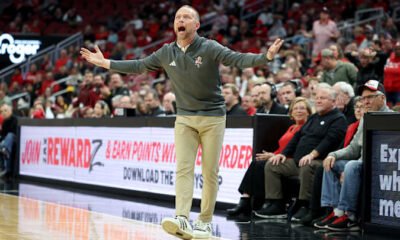Blog
Purdue boilermakers men’s basketball has just announced two key roster changes for 2025/2026.
Purdue Reloads: Braden Smith Returns and International Big Omer Mayer Joins — What It Means for the 2025–26 Boilermakers
If the 2024–25 season taught Purdue fans anything, it’s that the Boilermakers are never content to coast. After another deep March run and a Sweet 16 exit, Matt Painter’s program moved quickly in the offseason to shore up its core and add pieces that fit Purdue’s identity: tough, positionally versatile, and basketball-smart. In rapid succession this spring Purdue confirmed two roster moves that will shape expectations and the style of play for 2025–26 — the headline return of consensus All-American guard Braden Smith for his senior season, and the addition of international forward/center Omer Mayer to the roster. Both moves matter for different but complementary reasons: Smith brings continuity, leadership, and elite playmaking; Mayer brings size, rim presence and an international pedigree that can help stretch the floor and patrol the paint.
Braden Smith: The engine that chose to stay
Braden Smith’s announcement that he’ll return to West Lafayette was the offseason’s biggest single boost to Purdue’s title hopes. Smith, already a consensus first-team All-American and a Bob Cousy Award finalist for his point-guard excellence, made clear via social media that he wanted to finish what he started — to chase team goals and add to a legacy that, in two seasons, has already included elite playmaking and program records. His 2024–25 numbers — strong scoring, elite assist rates, defensive activity and high-level decision making — made him one of college basketball’s most important players, and his choice to return converts offseason uncertainty into clear continuity.
On the court, Smith is the kind of guard whose presence affects the whole roster. He averaged double-digit assists against high-level competition, handled late-game pressure with poise, and created open looks for big men and shooters alike. For a program that frequently reloads through the portal and recruiting, having a bona fide floor general return means offensive installs, identity and chemistry issues will be easier to manage. It also gives Matt Painter the flexibility to blend new pieces around a player who already understands the program’s tempo, rotations and expectations. Smith’s return doesn’t eliminate questions — matchup depth, interior scoring and wing defense remain priorities — but it buys the Boilermakers time and tactical advantage in the preseason and early Big Ten grind.
Omer Mayer: size, versatility and international polish
Less than a week after Smith’s return became the talk of Boiler Nation, Purdue made an addition that speaks to the changing, globalized face of college rosters: Omer Mayer, an international big who completed paperwork to join the program. Mayer brings length, mobility and a skill set that fits the modern frontcourt — he can guard multiple spots, finish at the rim, and has shown the touch and footwork that coaches covet in international prospects. Purdue’s announcement framed Mayer as an immediate addition who should help in rebounding, rim protection and interior spacing. In short, he’s the kind of big that can relieve perimeter mismatches and let the offense flow through Smith and other ballhandlers.
From a schematic standpoint, Mayer’s addition is forward-thinking. Big men who can move laterally and step out to contest or take a midrange jumper allow coaches to run more switching coverages and more motion-driven offense. For Purdue — historically strong at the five but increasingly emphasizing spacing and skill — Mayer represents an investment in a frontcourt that can physically hold its own while not completely sacrificing mobility. His international background also suggests a certain basketball IQ and fundamentals-first approach that usually translates well under veteran coaching staffs.
Bigger-picture roster calculus
Taken together, Smith’s return and Mayer’s arrival change the roster calculus in a few crucial ways. First, leadership and on-court direction: Smith’s return locks down the most important role on the team — the primary decision maker. That matters not only for execution but for recruiting and retention; players looking for stability see that Purdue can both develop talent and retain stars. Second, depth and matchup flexibility: Mayer’s size helps offset any interior departures and gives Painter the option to play bigger lineups without completely sacrificing pace. Third, the recruitment and transfer markets: adding Mayer signals Purdue’s reach — international scouting plus the ability to convince high-level players like Smith to stay — which could attract other portal or recruiting targets who want a program that blends tradition with modern assembly.
It’s also worth noting the offseason churn that hovered around the program: Purdue, like every major program, saw departures and portal activity this spring — players testing opportunities elsewhere and a few incoming names from across the transfer landscape. That reality makes the two announced moves feel even more vital: while other pieces rotate, the program’s spine — the coach, the anchor guard, and now an extension in the frontcourt — remains intact. That balance between stability and turnover is what separates teams that limp into the season from those that are contenders.
What to expect on the floor
If you sketch a hypothetical starting five for Purdue in 2025–26 with these moves in mind, the team looks like it will emphasize ball movement, inside-out creation and defensive toughness. Smith will be the primary orchestrator; wings and shooters will need to space and cut; Mayer will battle for rebounds and protect the paint. Against elite Big Ten forwards, Purdue’s success will hinge on whether Mayer (and any other bigs) can neutralize mismatches on the glass and deter second-chance points. Offensively, Smith’s return should produce more assisted buckets, better late-game execution and sustained tempo control. Paint it together, and you get a team that can play late in March.
Questions that remain
No offseason is without concerns. Purdue still needs wing depth and reliable secondary scoring beyond its primary creator. The transfer portal is unpredictable — more pieces could arrive or depart before the season starts. And while Mayer’s headline looks promising, how he adapts to Big Ten physicality and minutes demands is an open question. Coaching staff health, preseason practices and nonconference scheduling will further reveal how ready this team will be to compete for a conference crown. But the early indicators — continuity at point guard and added size inside — are positive and reduce the worry that once accompanies heavy offseason turnover.
For the fans: why this matters now
For Purdue fans, Smith’s choice to return is a cause for celebration — it’s a moment that says the program remains a destination where elite players can both develop and chase championships. Mayer’s signing, meanwhile, is a hint at a broader strategy: recruit and integrate talent from outside traditional pipelines, then meld them with homegrown and transfer talent. The result is a roster that looks built for the modern college game: skilled guards, versatile wings and bigs who can move. Those are the pieces that deepen tournament runs and create the kind of resilience needed in the long Big Ten slog.
Conclusion: A confident step forward — but the work continues
Purdue’s announcements that Braden Smith will return and Omer Mayer will join the program constitute two of the clearest signals that the Boilermakers intend to be contenders next season. Smith supplies experience, elite playmaking and leadership; Mayer brings size, interior defense and the kind of versatility that meshes with modern lineups. Together they reduce offseason uncertainty and lay a more defined path for where this team can go in 2025–26.
That said, college basketball’s landscape is fluid. The transfer portal, injuries, and player development will all shape how these moves ultimately look come February and March. For now, however, Boiler Nation has tangible reasons for optimism. With a proven All-American taking the helm and an international forward ready to patrol the paint, the program has reinforced two of its core pillars: on-court IQ and physicality. If Matt Painter and his staff can build around those pillars with reliable wing scoring and depth, Purdue might not only return to March but emerge as one of the more complete, battle-tested teams in the country.
-

 Blog5 months ago
Blog5 months agoPat Kelsey sends a strong three-word fiery message to the Louisville basketball’s team after their Cardinals 14th win…
-

 Blog7 months ago
Blog7 months agoNetflix releases “The Underdog,” a much-anticipated documentary about Drew Brees. slated for publication on the 25th
-

 Blog5 months ago
Blog5 months agoMikaela Shiffrin responds to cross-country skier Jessie Diggins’ letter following her failure to secure a solitary podium finish at the FIS Nordic Worlds
-

 Blog3 months ago
Blog3 months agoBehind the Turns: Netflix’s Upcoming Documentary on Mikaela Shiffrin’s Fights, Fears, and Love
-

 Blog4 months ago
Blog4 months agoLegacy Tour Led Zeppelin has officially confirmed their 2026 reunion tour, which will be their first extensive live performances since 2007. The “Led Zeppelin Legacy Tour 2026” will begin on June 10, 2026, at Los Angeles’ SoFi Stadium.
-

 Blog5 months ago
Blog5 months agoWomen’s Slalom Run 1 at the FIS Alpine Skiing World Cup: Are
-

 Blog5 months ago
Blog5 months ago“Courtside to Aisle-Side: Tyrese Haliburton and Jade Jones Set New Wedding Date”
-

 Blog7 months ago
Blog7 months agoFederica Brignone: “I’m fine, but my return to skiing is far off.”
